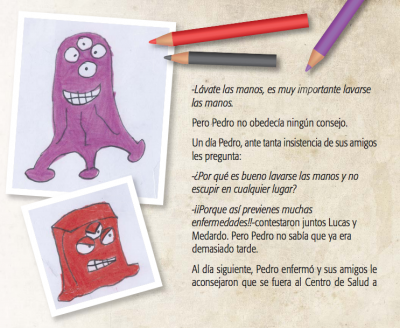Child-to-Child Ecuador Launches Project Stressing Harmony with Microbes
May 2015
By Celine Woznica
On June 11-12, 2015 in Cuenca, Ecuador the Centro Niño-a-Niño (Child to Child Centre) will be hosting a seminar-workshop to share its new educational toolkit “Alforja Educativa: Salud Escolar y Mundo Microbiano” (“Educational Knapsack: Student Health and the Microbial World”). The result of a three-year project with children, it is a child-friendly collection of activity guides, songs, videos, and storybooks about the important role of microbes and the interactions between humans, the microbial world and nature. The toolkit is designed for use in both the community and school settings. The conference will also focus on Child to Child methodology and the role of art and play in the learning process. The exchange of experiences and resources in promoting child health will be promoted in the seminar setting.
Located in the highlands of Cuenca, Ecuador, Centro Niño-a-Niño is steeped in rich Andean culture and traditions. The centre’s indigenous roots are reflected in its philosophy of Sumak Kawsay, literally translated as “good living” but signifying a core commitment to the fullness of life and harmony among all beings. Child-focused activities are grounded in the belief that health is the fruit of this harmony and results when there are good relations with nature, with others, and with oneself. Without Sumak Kawsay, good health does not exist.
Child to Child activities address lack of harmony
Child to Child’s 6-step methodology adapts easily to Sumak Kawsay, empowering children to recognise, study, and take action where there is a lack of harmony in nature, including the nearly invisible world of microbes.
Three years ago with the support of ReAct Latinamerica, Centro Niño-a-Niño developed a school-based programme to promote child health within the framework of Sumak Kawsay and examining the role of microbes in maintaining harmonic balance. “Student Health and the Microbial World” was interwoven with existing school curriculum and incorporated participatory teaching techniques such as play and art. Using such child-friendly techniques assured the role of children as protagonists in learning and in teaching others.
Tackling the resistance to antibiotics with children: through the world of microbes
“We started off working with the children and teachers in these schools on the theme of antibiotic resistance* but very soon it was clear that the entry point into their hearts and minds was through the world of microbes,” said Silvina Alessio, Coordinator of the ReAct’s Civil Society Organisation (CSO) project for Centro Niño-a-Niño, at the press conference.
Listening to the children’s interests and adapting the project in accordance was key to its success. The children were very active in the project and gained a concrete understanding of the issues at hand as well as improved their knowledge of health and hygiene.
Last year the children even published a book of their stories, which illustrates their comprehension of the way microbes benefit human beings – for instance by producing food and helping with digestion – and of the microbial world. At the press conference launching the book in June 2014, a child explained that, “Microbes communicate and cooperate with each other because an individual microbe cannot make chocolate or cheese on its own; it needs friends to do the job.”
For more information about the book and the project, watch this video (in Spanish) or read the newsletter (in Spanish).
For more information about and to register for the seminar, see here.
You can also contact Centro Niño-a-Niño:
Telf: 593-7-2841865
Correo: ninoanino@gmail.com
*Reflecting Sumak Kawsay philosophy, the programme focused on a growing disharmony among humans, the microbial world, and nature. This disharmony is the result of the indiscriminate use of antibiotics in farming, agriculture, and health care. Often the consequence of aggressive marketing by pharmaceutical companies and the lack of affordable health care that forces people to inappropriately self-medicate with antibiotics, the imbalance is manifested in alarming rates of antibiotic resistance. As a result, doctors are finding it difficult to treat common diseases once easily cured with common antibiotics. And within the cosmovision of Sumak Kawsay, the imbalance highlights a disrespect for the world of microbes that do play an important role in nature and in our bodies.

